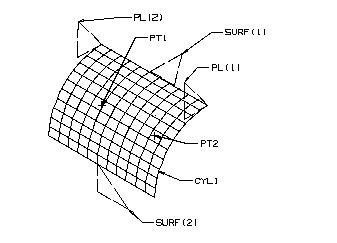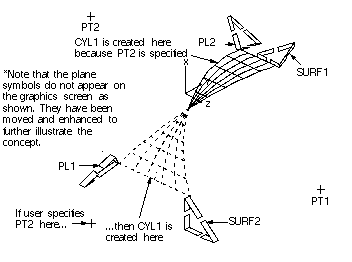$$ Declarations
$$
ENTITY/PT1,PT2,SURF(2),PL(2),CYL1
$$
$$ Geometry Definition
$$
PT1 = POINT/0,0,0
PT2 = POINT/-1,-1,0
SURF(1)= PLANE/XYPLAN,1
SURF(2)= PLANE/XZPLAN,-1
PL(1) = PLANE/YZPLAN,0
PL(2) = PLANE/YZPLAN,-2
$$
$$ Cylinder Definition
$$
CYL1 = CYLNDR/SURF(1),SURF(2),CENTER,PT1, $ RADIUS,1,PL(1),PL(2),PT2

Fillet Cylinder Bounded by Two Parallel Bounding Planes
Example
Creating a cylinder tangent to two previously defined sheets. The cylinder is bounded by two planes (PL(1) and PL(2)). In this case the planes intersect causing the possibility of two cylinder halves to be created. The half closest to PT2 is created.
$$
$$ Declarations
$$
ENTITY/PT1,PT2,SURF(2),P(6),PL(2),CYL1
$$
$$ Geometry Definition
$$
PT1 =POINT/0,1,-1
PT2=POINT/0,-1,0
SURF(1)=PLANE/XYPLAN,0
SURF(2)=PLANE/XZPLAN,0
P(1) =POINT/0,0,0
P(2)=POINT/0,1,0
P(3)=POINT/1,0,1
P(4)=POINT/-.5,0,0
P(5)=POINT/-.5,1,0
P(6)=POINT/-1,0,1
PL(1)=PLANE/P(1..3)
PL(2)=PLANE/P(4..6)
BLANK/P(1..6)
$$
$$ Cylinder Definition
$$
CYL1=CYLNDR/SURF(1),SURF(2),CENTER,PT1,$
RADIUS,1,PL(1),PL(2),PT2

Fillet Cylinder Bounded by Two Non-parallel Planes
In the figure shown above, the upper cylinder half is created because of its proximity to PT2. If PT2 had been specified in -Z, the lower cylinder half would have been created.